Guide to Head Diseases of Wheat and Barley in Montana
Dr. Mary Burrows, Extension Plant Pathology Specialist, Montana State University
Contents
- Fusarium head blight (scab) of wheat and barley (Fusarium spp.)
- Common bunt (stinking smut, covered smut) of wheat (Tilletia tritici or T. laevis)
- Dwarf bunt (TCK) of winter wheat (Tilletia controversa Kuhn)
- Loose smut of wheat and barley (Ustilago tritici)
- Ergot of wheat and barley (Claviceps purpurea)
- Black chaff of wheat and barley (Xanthomas spp.)
- Melanism (abiotic)
- Black point (kernel smudge) (various fungi)
- Sooty mold (primarily Alternaria, but other fungi can be involved)
- Acknowledgments
Fusarium head blight (scab) of wheat and barley (Fusarium spp.)
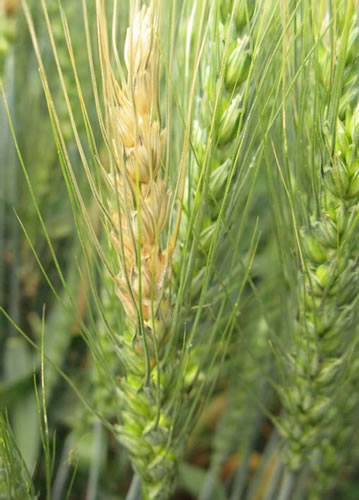
- Symptoms
- Partial bleaching of the head
- Brown stems on very susceptible varieties
- If moist, pink/orange fungal mycelia
- Risk Factors
- Continuous wheat or barley production
- Moist conditions at flowering
- Previous history of scab
- Management
- Crop rotation, cut irrigation 10 days before flowering and through the flowering period
- Resistant varieties
- Fungicides applied at or before flowering
Common bunt (stinking smut, covered smut) of wheat (Tilletia tritici or T. laevis)
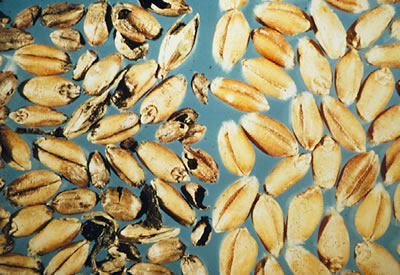
- Symptoms
- Grain kernels replaced with brown masses of spores known as smut balls
- Fishy smell
- Risk Factors
- Contaminated seed, often from previous crop
- Management
- Resistant cultivars
- Fungicide seed treatment
- New seed source
Dwarf bunt (TCK) of winter wheat (Tilletia controversa Kuhn)
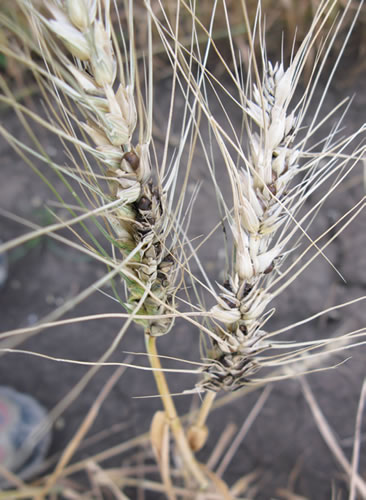
- Symptoms
- Grain kernels replaced with brown masses of spores known as smut balls
- Fishy smell
- Plants and heads are stunted/dwarfed
- Risk Factors
- Contaminated seed, often from previous crop
- Management
- Resistant cultivars
- Systemic fungicide seed treatment
- New seed source
Loose smut of wheat and barley (Ustilago tritici)
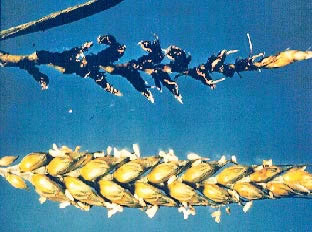
- Symptoms
- Grain kernels replaced with green-brown masses of spores covered by a thin membrane
- Spores disperse within days of head emergence
- Risk Factors
- Contaminated seed, often from previous crop
- Management
- Resistant cultivars
- Systemic fungicide seed treatment
- New seed source
Ergot of wheat and barley (Claviceps purpurea)
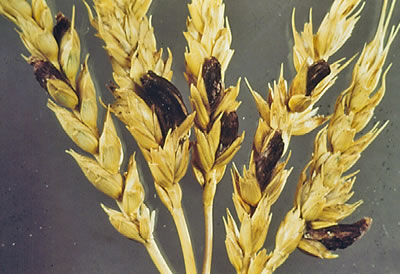
- Symptoms
- Grain kernels replaced with solid purple-black mass of fungal hyphae called a sclerotia
- if wet after flowering honeydew (sticky mass of fungal conidia) can be observed on infected heads
- Risk Factors
- Contaminated seed, often from previous crop
- Management
- Crop rotation to non-grass crop
- Tillage to bury sclerotia
- Clean seed
Caution: Ergot is toxic to humans and animals (ergotism)
Black chaff of wheat and barley (Xanthomas spp.)
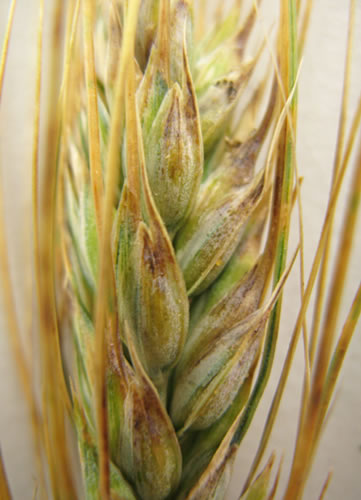
- Symptoms
- Red/brown/black streaks on glumes
- Watersoaked spots on leaves and/or glumes
- Risk Factors
- Contaminated seed, often from previous crops
- Can also be on residue or soilborne
- Management
- Crop rotation to non-grass crop
- Tillage to bury residue\
- Clean seed
Melanism (abiotic)
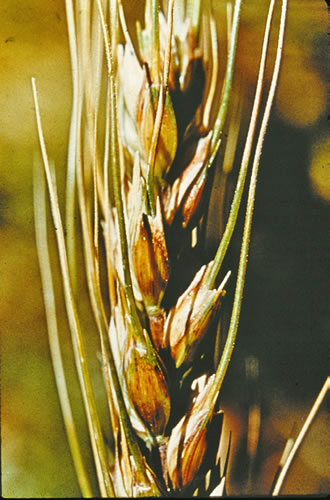
- Symptoms
- Red/brown/black streaks on glumes
- No spots on leaves, although stems or nodes may also be dark
- Risk Factors
- Stress (particularly heat stress)
- Variety (genetics)
- Management
- Variety selection
Black point (kernel smudge) (various fungi)
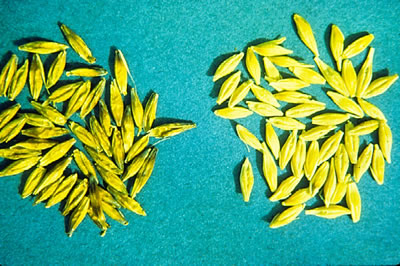
- Symptoms
- Glumes, other tissues covered with black, sooty-appearing mold
- Diseased kernels are discolored, weathered, black at seed ends
- Embryos often shriveled and brown to black in color
- Risk Factors
- Warm, moist weather during maturation
- Delayed harvest
- Management
- None practical, avoid moisture during crop storage
Sooty mold (primarily Alternaria, but other fungi can be involved)
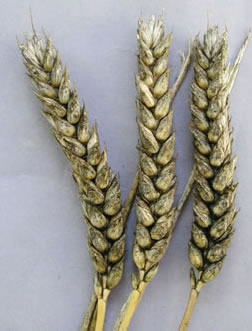
- Symptoms
- Glumes, other tissues covered with black, sooty-appearing mold
- Diseased kernels are discolored, weathered, black at seed ends
- Embryos often shriveled and brown to black in color
- Risk Factors
- Warm, moist weather during maturation
- Delayed harvest
- Management
- None practical, avoid moisture during crop storage
Acknowledgments
Photos courtesy of MSU Plant Pathology Department slide collection, CIMMYT, and HGCA.
Original July 2009 PDF (2.5MB)
